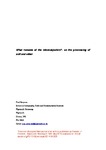What remains of the intersubjective?: on the presencing of self and other
| dc.contributor.author | Simpson, P | |
| dc.date.accessioned | 2016-01-25T12:51:00Z | |
| dc.date.accessioned | 2016-07-01T08:27:27Z | |
| dc.date.available | 2016-01-25T12:51:00Z | |
| dc.date.available | 2016-07-01T08:27:27Z | |
| dc.date.issued | 2015-02-01 | |
| dc.identifier.issn | 1755-4586 | |
| dc.identifier.issn | 1878-0040 | |
| dc.identifier.uri | http://hdl.handle.net/10026.1/5009 | |
| dc.description.abstract |
Recent work in the social sciences has been concerned with how we understand the subject. This has entailed critiquing the ways the subject has traditionally been understood - as a mental entity existing prior to and so organizing our experience of the world. In its place a relational subject has been posited, one emerging through a combination of affective experiences, performative enunciations, and haunting absent presences. However, the implications of such critiques for how we understand intersubjective relations have not been discussed. What remains of intersubjectivity when any subject entering into a relation has already been decentred amid a more-than human ecology of affective relations? In response, this paper draws on the work of Jean-Luc Nancy in developing understandings of the socio-spatial constitution of subjectivity/intersubjectivity in terms of movements of presencing. Here the body-subject is always in approach to itself and others, but neither is actually reached, never (self) present, always already receding: a spacing at the heart of any relation. The discussion is interspersed with a series of narrative sections outlining an encounter between a street performer and their audience which draw attention to a number of key themes in any understanding of intersubjectivity and attempt to expose this inherent dis-position. | |
| dc.format.extent | 65-73 | |
| dc.language | en | |
| dc.language.iso | en | |
| dc.publisher | Elsevier BV | |
| dc.relation.replaces | http://hdl.handle.net/10026.1/4222 | |
| dc.relation.replaces | 10026.1/4222 | |
| dc.subject | Affect | |
| dc.subject | Body | |
| dc.subject | Intersubjectivity | |
| dc.subject | Jean-Luc Nancy | |
| dc.subject | Performance | |
| dc.subject | Subjectivity | |
| dc.title | What remains of the intersubjective?: on the presencing of self and other | |
| dc.type | journal-article | |
| dc.type | Article | |
| plymouth.author-url | https://www.webofscience.com/api/gateway?GWVersion=2&SrcApp=PARTNER_APP&SrcAuth=LinksAMR&KeyUT=WOS:000351968000014&DestLinkType=FullRecord&DestApp=ALL_WOS&UsrCustomerID=11bb513d99f797142bcfeffcc58ea008 | |
| plymouth.issue | 1 | |
| plymouth.volume | 14 | |
| plymouth.publication-status | Published | |
| plymouth.journal | Emotion, Space and Society | |
| dc.identifier.doi | 10.1016/j.emospa.2014.04.003 | |
| plymouth.organisational-group | /Plymouth | |
| plymouth.organisational-group | /Plymouth/Faculty of Science and Engineering | |
| plymouth.organisational-group | /Plymouth/Faculty of Science and Engineering/School of Geography, Earth and Environmental Sciences | |
| plymouth.organisational-group | /Plymouth/REF 2021 Researchers by UoA | |
| plymouth.organisational-group | /Plymouth/REF 2021 Researchers by UoA/UoA14 Geography and Environmental Studies | |
| plymouth.organisational-group | /Plymouth/Users by role | |
| plymouth.organisational-group | /Plymouth/Users by role/Academics | |
| dc.identifier.eissn | 1878-0040 | |
| dc.rights.embargoperiod | Not known | |
| rioxxterms.versionofrecord | 10.1016/j.emospa.2014.04.003 | |
| rioxxterms.licenseref.uri | http://www.rioxx.net/licenses/all-rights-reserved | |
| rioxxterms.type | Journal Article/Review |


